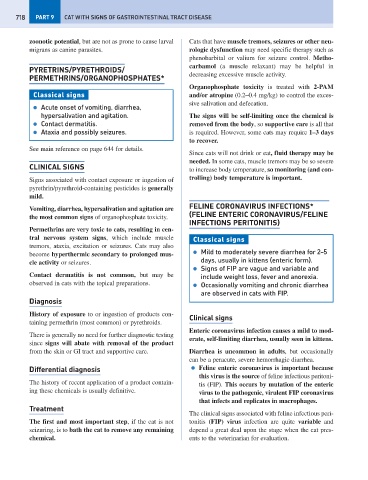Page 726 - Problem-Based Feline Medicine
P. 726
718 PART 9 CAT WITH SIGNS OF GASTROINTESTINAL TRACT DISEASE
zoonotic potential, but are not as prone to cause larval Cats that have muscle tremors, seizures or other neu-
migrans as canine parasites. rologic dysfunction may need specific therapy such as
phenobarbital or valium for seizure control. Metho-
carbamol (a muscle relaxant) may be helpful in
PYRETRINS/PYRETHROIDS/
PERMETHRINS/ORGANOPHOSPHATES* decreasing excessive muscle activity.
Organophosphate toxicity is treated with 2-PAM
Classical signs and/or atropine (0.2–0.4 mg/kg) to control the exces-
sive salivation and defecation.
● Acute onset of vomiting, diarrhea,
hypersalivation and agitation. The signs will be self-limiting once the chemical is
● Contact dermatitis. removed from the body, so supportive care is all that
● Ataxia and possibly seizures. is required. However, some cats may require 1–3 days
to recover.
See main reference on page 644 for details.
Since cats will not drink or eat, fluid therapy may be
needed. In some cats, muscle tremors may be so severe
CLINICAL SIGNS to increase body temperature, so monitoring (and con-
Signs associated with contact exposure or ingestion of trolling) body temperature is important.
pyrethrin/pyrethroid-containing pesticides is generally
mild.
FELINE CORONAVIRUS INFECTIONS*
Vomiting, diarrhea, hypersalivation and agitation are
(FELINE ENTERIC CORONAVIRUS/FELINE
the most common signs of organophosphate toxicity.
INFECTIONS PERITONITIS)
Permethrins are very toxic to cats, resulting in cen-
tral nervous system signs, which include muscle Classical signs
tremors, ataxia, excitation or seizures. Cats may also
● Mild to moderately severe diarrhea for 2–5
become hyperthermic secondary to prolonged mus-
days, usually in kittens (enteric form).
cle activity or seizures.
● Signs of FIP are vague and variable and
Contact dermatitis is not common, but may be include weight loss, fever and anorexia.
observed in cats with the topical preparations. ● Occasionally vomiting and chronic diarrhea
are observed in cats with FIP.
Diagnosis
History of exposure to or ingestion of products con-
Clinical signs
taining permethrin (most common) or pyrethroids.
Enteric coronavirus infection causes a mild to mod-
There is generally no need for further diagnostic testing
erate, self-limiting diarrhea, usually seen in kittens.
since signs will abate with removal of the product
from the skin or GI tract and supportive care. Diarrhea is uncommon in adults, but occasionally
can be a peracute, severe hemorrhagic diarrhea.
Differential diagnosis ● Feline enteric coronavirus is important because
this virus is the source of feline infectious peritoni-
The history of recent application of a product contain- tis (FIP). This occurs by mutation of the enteric
ing these chemicals is usually definitive. virus to the pathogenic, virulent FIP coronavirus
that infects and replicates in macrophages.
Treatment
The clinical signs associated with feline infectious peri-
The first and most important step, if the cat is not tonitis (FIP) virus infection are quite variable and
seizuring, is to bath the cat to remove any remaining depend a great deal upon the stage when the cat pres-
chemical. ents to the veterinarian for evaluation.

